LED Hotspot
 A ground-breaking technology known as Li-Fi could be the next big thing in data communications. And it would turn every LED lightbulb into a wireless hotspot, enabling secure, high-speed, ubiquitous data networks.
A ground-breaking technology known as Li-Fi could be the next big thing in data communications. And it would turn every LED lightbulb into a wireless hotspot, enabling secure, high-speed, ubiquitous data networks.
First introduced in 2011, visible light communications is now being tested in real-world office and industrial environments, where researchers have achieved speeds as high as 224 Gigabits per second (Gbps). Although, at that rate, you would be able to download 18 full-length films in one second, the goal for bringing Li-Fi to market is a mere 1 Gbps (which is still about 100 times faster than current Wi-Fi technology). It works by modulating the intensity of LED bulbs at very high speeds.
Li-Fi technology brings with it several benefits. First, because it uses bulbs that are already providing illumination, it costs virtually nothing to operate in terms of energy. In fact, the bulbs can be turned down to the point where they appear to be off and still transmit data. Secondly, Li-Fi is less expensive to install than Wi-Fi and would provide free data access anywhere there’s a lightbulb. Finally, Li-Fi is more secure. Because light doesn’t penetrate walls, data is only available to users in the same room.
Drawbacks of the technology include the fact that it doesn’t currently function outdoors, and light pollution can present issues. However, the developers are confident that Li-Fi will someday replace unsightly radio frequency towers.
For information: Harald Haas, pureLiFi Ltd., Edinburgh Technology Transfer Centre, Alrick Building, Max Born Crescent, EH9 3BF, Edinburgh, United Kingdom; phone: +44-131-472-4807; email: info@purelifi.com; Web site: www. http://purelifi.com/